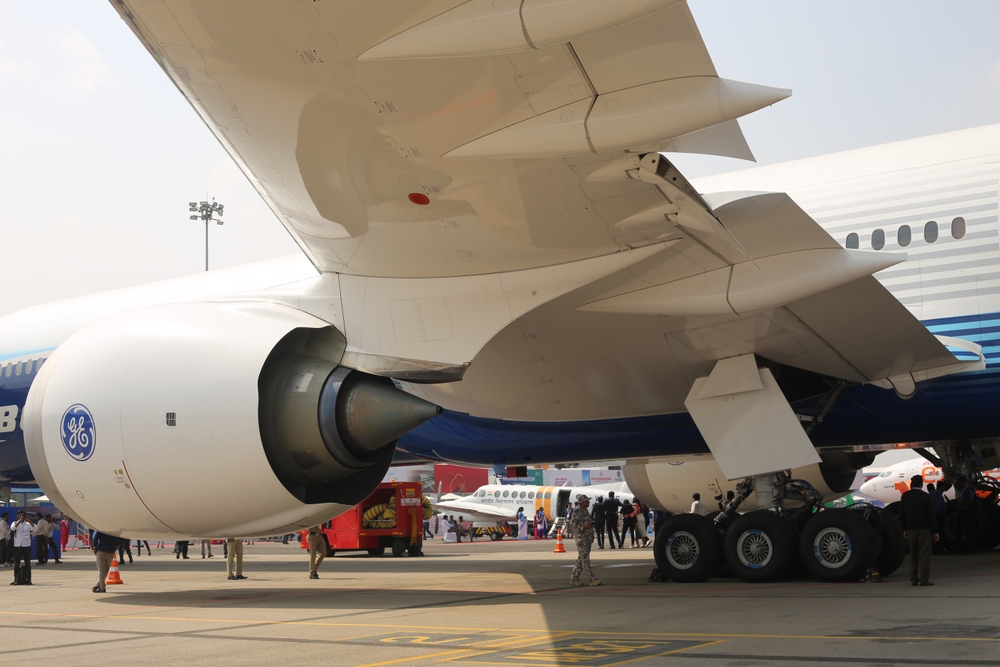Discover how the GE9X engine powers the Boeing 777X with record-breaking efficiency, advanced materials, and low emissions for next-gen sustainable aviation.
Table of Contents
The GE9X: Engineering Marvel

The GE9X, developed by General Electric’s aviation division, represents a significant advancement in jet engine technology. It is designed for the new Boeing 777X aircraft, bringing innovations that enable improved performance, efficiency, and sustainability.
Technical Specifications
The GE9X boasts impressive specifications. It has a fan diameter of 134 inches, the largest for any jet engine, providing substantial thrust. The engine generates a maximum thrust of 105,000 pounds but operates with lower thrust to optimize fuel efficiency and reduce emissions. Each blade is crafted from carbon fiber composite material, providing strength while reducing weight.
It features an overall pressure ratio of 60:1, which is higher than its predecessors. This high pressure ratio improves the engine’s thermal efficiency, making it more fuel-efficient and environmentally friendly.
Materials and Design
Materials play a vital role in the GE9X’s success. Engineers used advanced ceramic matrix composites (CMCs) in the high-pressure turbine section. These materials embody high-temperature tolerance that allows for greater efficiency and reduced cooling needs.
Additionally, the fan blades and fan case are made from lightweight carbon fiber composites. This reduces the engine’s overall weight, contributing to better fuel economy and lower carbon dioxide emissions.
Environmental Impact
The GE9X is designed with environmental considerations at the forefront. It offers a 10% improvement in specific fuel consumption compared to its predecessor, the GE90. This translates to fewer emissions, making it one of the greenest engines in the market.
Strict emissions regulations necessitate that modern engines produce lower NOx emissions. It achieves this by operating at cooler temperatures, thus producing fewer nitrogen oxide. It also employs an advanced combustor system that reduces soot and other particulate emissions.
Maintenance and Durability
Ease of maintenance and durability are cornerstones of the GE9X design. The engine incorporates fewer but more durable components. This simplification leads to a reduction in the overall maintenance costs and downtime.
Engineers also focused on the durability of components. The use of CMCs and carbon fiber composites means the engine can withstand higher temperatures and stress levels. This durability extends the time between overhauls, contributing to cost-efficiency for airlines.
Testing and Certification
Before entering service, the GE9X underwent rigorous testing. General Electric conducted extensive ground and flight tests to ensure the engine meets and surpasses all safety and performance standards. This process involved over 5,000 hours of testing, including extreme weather simulations, to verify reliability.
Certification is a critical step for any new engine. The GE9X earned its Federal Aviation Administration (FAA) certification in 2018, marking a significant milestone. This certification reassured customers about the safety and readiness of the engine for commercial use.
Technological Innovations
The GE9X incorporates a myriad of technological innovations. One key innovation is the twin-annular pre-swirl (TAPS) III combustor. This design improves fuel efficiency and reduces emissions by mixing fuel and air more effectively.
The engine control system has also been upgraded. Using Full Authority Digital Engine Control (FADEC), the GE9X operates seamlessly with advanced diagnostic and operational capabilities. This system ensures optimal performance and simplifies troubleshooting and maintenance.
Market Impact
The GE9X significantly impacts the aviation market. Airlines that adopt the Boeing 777X, equipped with GE9X engines, benefit from enhanced fuel efficiency and reduced operating costs. These advantages make routes more economically viable and can help airlines improve their profit margins.
The environmental benefits also align with the industry’s push towards greener technology. Airlines can meet stringent regulatory requirements while improving their public image concerning environmental responsibility.
Future Prospects
Looking ahead, the GE9X sets a new benchmark for future jet engine developments. Its success encourages continued innovation in materials, design, and efficiency. Engineers will likely build upon this foundation to develop even more advanced engines.
The lessons learned from the GE9X project will influence both commercial and military aviation. The technology and materials innovations are likely to be adapted for various applications, showcasing the engine’s broader impact on the aerospace industry.
Conclusion
The GE9X stands as a testament to modern engineering prowess, blending advanced materials, innovative design, and environmental considerations. Its adoption by airlines promises economic and ecological benefits while setting new standards for future aviation technologies.

